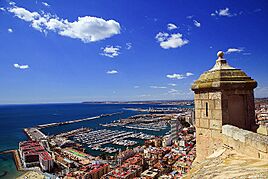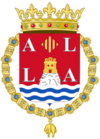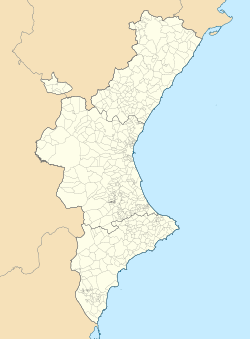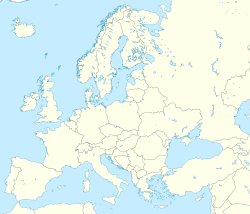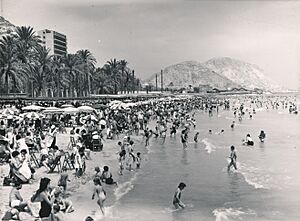Alicante facts for kids
Quick facts for kids
Alicante
|
|||
|---|---|---|---|
| Alicante / Alacant (official) | |||
|
View of the harbour with the Castle of Santa Bárbara in the foreground
Explanada de España
Gran Sol
Casa Carbonell
City hall
Beach of El Postiguet
|
|||
|
|||
| Country | |||
| Autonomous Community | |||
| Province | |||
| Comarca | Alacantí | ||
| Founded | 324 BC | ||
| Area | |||
| • Total | 201.27 km2 (77.71 sq mi) | ||
| Elevation
(AMSL)
|
3 m (10 ft) | ||
| Population
(2022-1-1)
|
|||
| • Total | 348,901 | ||
| • Rank | 10 | ||
| • Density | 1,733.50/km2 (4,489.74/sq mi) | ||
| Demonyms | • alicantino, -na (es) • alacantí, -ina (va) |
||
| GDP | |||
| • Metro | €34.014 billion (2020) | ||
| Time zone | UTC+1 (CET) | ||
| • Summer (DST) | UTC+2 (CEST) | ||
| Postal code |
03000–03016
|
||
| Area code(s) | +34 (ES) + 96 (A) | ||
| Administrative Divisions | 12 | ||
| Neighborhoods | 45 | ||
| Climate | BSh | ||
Alicante (officially: Alicante / Alacant) is a beautiful city and municipality in the Valencian Community, Spain. It is the main city of the province of Alicante and a very old Mediterranean port. In 2020, about 337,482 people lived in Alicante, making it the second-largest city in the Valencian Community.
Contents
Discovering Alicante's Name
The name Alicante comes from the old Arabic name Laqant. This Arabic name itself came from the Latin name Lucentum and the Greek word Leuké. Leuké means "white". So, Alicante's name has a long history, linking it to ancient languages and meanings.
Alicante Through Time
The area around Alicante has been home to people for over 7,000 years! The first groups of hunter-gatherers arrived from Central Europe a very long time ago. Some of the earliest settlements were on the slopes of Mount Benacantil.
Ancient Settlements and Empires
Around 1000 BC, traders from Greece and Phoenicia started visiting Spain's eastern coast. They set up small trading ports. They also taught the local Iberian tribes about the alphabet, how to use iron, and the pottery wheel.
In the 230s BC, a Carthaginian general named Hamilcar Barca built a strong settlement called Akra Leuké. This name means "White Mountain" or "White Point". Most people think this was built where Alicante is today.
Even though the Carthaginians took over much of the land, the Romans eventually ruled for over 700 years. By the 5th century AD, the Roman town of Alicante, called Lucentum, was controlled by the Visigothic people.

From Moorish Rule to Spanish Kingdoms
The Visigoths did not fight much when the Arabs arrived in the early 8th century. The Moors then ruled southern and eastern Spain until the 13th century. This was when the Reconquista (Reconquest) happened.
Alicante was taken back in 1247 by the Castilian king Alfonso X. But later, in 1296, it became part of the Kingdom of Valencia under King James II of Aragon. It became a "Royal Village" and had a say in the local parliament.
Trade and Challenges in Later Centuries
After some wars between the Crown of Castile and the Crown of Aragon, Alicante became an important trading port. It exported goods like rice, wine, olive oil, oranges, and wool.
However, between 1609 and 1614, King Felipe III made thousands of Moriscos leave Valencia. These were people who had stayed after the Reconquista. This decision hurt the region's economy a lot, as many skilled workers were gone.
Things got worse in the early 18th century after the War of Spanish Succession. Alicante slowly declined. It survived by making shoes, growing crops like oranges and almonds, and fishing. The late 1800s saw a comeback for the local economy. International trade grew, and the city's port became busier, especially during World War I when Spain was neutral.
Modern History and Growth
In the early 20th century, Alicante benefited from Spain's neutrality during World War I. This brought new chances for local businesses and farms. In the 1920s, many people from Alicante were sent to fight in a war in North Africa.
Political changes in the late 1920s led to the king leaving the country. The Second Spanish Republic was announced on April 14, 1931, and people in Alicante celebrated.
The Spanish Civil War began on July 17, 1936. Alicante was the last city loyal to the government to be taken by the opposing side on April 1, 1939. Many government officials fled from its harbor. Alicante was heavily bombed during the war. A notable bombing happened on May 25, 1938, at the market, where many civilians died.
A British ship, the SS Stanbrook, played a heroic role in 1939. Its captain, Archibald Dickson, helped thousands of Spanish families escape during the war, even under bombing.
From 1954 onwards, many people from Algeria, called pied-noirs, moved to Alicante. This happened especially after Algeria became independent in 1962. Alicante had strong connections with the city of Oran in Algeria.
In the late 1950s and early 1960s, tourism began to change Alicante. Big buildings and resorts were built near the beaches. The good weather attracted many visitors and buyers. This growth in tourism also led to new restaurants, bars, and other businesses. A new airport, El Altet Airport, was built, making it easier for tourists to arrive.
After Franco's death in 1975, Spain became a democratic country. Regions like Valencia gained more self-rule.
The Port of Alicante has changed a lot since the 1980s. It lost much of its shipping business to Valencia. But in recent years, it has become a very important port for cruise ships. In 2007, 72 cruise ships visited, bringing many passengers and crew to the city. Developing the port for tourism has been popular. However, plans to build an industrial area in the port have caused some debate.
Alicante's Location and Landscape
Alicante is in the southeast of the Iberian Peninsula, right on the Mediterranean Sea. The city is mostly flat, but some hills rise up, like Cabo de la Huerta, Serra Grossa, Tosal, and Benacantil.
Alicante is in a dry area, so it doesn't have big rivers. It has some stream beds that fill up only when it rains a lot. There used to be a swamp called l'Albufereta, but it was drained in 1928.
The city also has two small areas of land separate from the main city. One is Monnegre, and the other is Cabeçó d'Or, which includes part of the Cabeçó d'Or mountain (1209 meters high). The small island of Tabarca, about 8 nautical miles south of the city, also belongs to Alicante.
The main staircase of the City Hall Building is considered the "zero point" for measuring height above or below sea level in Spain. This is because the Mediterranean Sea in Alicante has very small tide changes.
Alicante's Economy
Before a recent economic downturn, Alicante was one of Spain's fastest-growing cities. This growth was mainly due to tourism and a boom in building second homes. Many people bought holiday homes, especially from the 1960s onwards.
Services and public administration are also very important to the city's economy. The building boom raised concerns about the environment. The local government has been watched closely by the European Union. Plans to build an industrial area in the port caused a lot of discussion.
Alicante is home to the European Union Intellectual Property Office. This means many European public workers live here.
The University of Alicante campus is just outside the city, in San Vicente del Raspeig. More than 25,000 students attend this university.
Between 2005 and 2012, Alicante had Ciudad de la Luz (City of Light). This was one of the biggest film studios in Europe. It made Spanish and international movies. However, it was closed in 2012.
Alicante's Climate
Alicante has mild winters and hot, humid summers. It doesn't rain much, and most rain falls in spring and autumn. The city has a hot semi-arid climate, which means it's one of the driest cities in Europe.
Temperatures don't change much during the day because the sea keeps them steady. However, sometimes westerly winds can cause big temperature changes. Winters are mild, and summers are hot. In summer, the air is very humid because of the warm Mediterranean water. This makes it feel even hotter.
The city gets about 311 mm of rain each year. September and October are the wettest months. Sometimes, the rain can be very heavy, causing floods. On average, there are only about 35 rainy days a year. Alicante gets a lot of sunshine, around 2,851 hours per year.
The highest temperature ever recorded was 42.0 °C on August 13, 2022. The lowest was -4.6 °C on February 12, 1956. Very cold temperatures are rare. The last time it snowed was in 1926. Alicante has some of the sunniest and warmest winter days in mainland Europe.
People of Alicante
In 2022, Alicante had 338,577 people living there. The larger metropolitan area, including Elche, had 768,194 people. About 17.7% of the population in 2022 were from other countries. Many of these people moved to Alicante in the last 20 years. Also, many retirees from Northern Europe live in Alicante but are still officially residents of their home countries.
| Country of Birth | Men | Women | Total |
|---|---|---|---|
| 4845 | 3047 | 7892 | |
| 2695 | 3234 | 5929 | |
| 2720 | 2104 | 4824 | |
| 2252 | 1819 | 4071 | |
| 1829 | 2097 | 3926 | |
| 1176 | 1799 | 2975 | |
| 1075 | 1404 | 2479 | |
| 1239 | 1226 | 2465 | |
| 946 | 1285 | 2231 | |
| 1037 | 1092 | 2129 | |
| 940 | 960 | 1900 | |
| 801 | 616 | 1417 | |
| 646 | 621 | 1267 | |
| 642 | 448 | 1090 | |
| 543 | 542 | 1085 |
Getting Around Alicante
Air Travel
Alicante Airport is the busiest airport in the Valencian Community. It is one of the busiest in Spain. You can fly from Alicante to Madrid, Barcelona, and many cities in Western Europe. There are also regular flights to Algeria.
Train Travel
Alicante railway station has local trains that connect Alicante with nearby towns and Murcia. Longer-distance trains go to Madrid, Barcelona, and Valencia. In 2013, a high-speed rail line was extended to Alicante. This allows fast AVE trains to connect to Madrid.
Tram and Ferry Services
The Alicante Metropolitan-Tram connects different parts of the city and nearby areas along the Costa Blanca. As of 2020, electric tram-trains go to Benidorm, and diesel trains go further to Dénia.
The city also has regular ferry services to the Balearic Islands and Algeria. Alicante is a strong city with a large harbor.
Top Sights in Alicante
Two of the most famous places in Alicante are the Castle of Santa Bárbara and the port of Alicante. The port was in the news in 2006–2007 because people successfully fought to stop it from becoming an industrial area.
Santa Bárbara Castle
The Santa Bárbara castle sits on Mount Benacantil, looking over the city. The oldest part is the tower at the top. Some of the lower parts and walls were built later, in the 18th century.
Explanada de España
The Explanada de España is a beautiful promenade lined with palm trees. It's paved with 6.5 million marble tiles that create a wavy pattern. This walkway goes from the Port of Alicante to the Gran Vía. It's a popular spot for locals to take an evening stroll and enjoy outdoor concerts.
Historic Neighborhoods and Parks
Barrio de la Santa Cruz is a colorful old part of the city. It's located southwest of Santa Bárbara castle. Its small houses climb up the hill, with narrow streets decorated with flags and flowers.
L'Ereta Park is at the foot of Mount Benacantil. It goes from the Santa Bárbara castle down to the old city. It has different levels, paths, and resting spots that offer amazing views of Alicante.
El Palmeral Park is a favorite park for people in Alicante. It has walking trails, playgrounds for kids, ponds, picnic tables, and an outdoor stage for concerts.
Just a few kilometers from Alicante, in the Mediterranean Sea, is Tabarca island. This island used to be a hideout for pirates, but now it's a popular place for tourists to visit.
Other Interesting Places
- Basilica of Santa María (14th–16th centuries): Built in Gothic style over an old mosque.
- Co-cathedral of St. Nicholas of Bari (15th–18th centuries): Also built over a mosque, it's the main church of Alicante.
- Monastery of Santa Faz (15th century): About 5 km outside the city, in Baroque style.
- Defence towers of the Huerta de Alicante (15th–18th centuries): Built to protect against pirates. About 20 towers still stand today.
- Baroque Casa de La Asegurada (1685): The oldest civil building in the city. It now houses the Museum of Contemporary Art of Alicante.
- Casa consistorial de Alicante (18th century): The city hall, also in Baroque style.
- Gravina Palace (1748–1808): Now home to the Gravina Museum of Fine Arts.
Museums in Alicante
Alicante has many museums. The Archaeological Museum of Alicante (MARQ) shows local items from 100,000 years ago to the early 20th century. It won the European Museum of the Year Award in 2004. The Gravina Museum of Fine Arts has paintings and sculptures from the 16th to 19th centuries. The Asegurada Museum of Contemporary Art has a large collection of 20th-century art.
Fun Festivals in Alicante
The most important festival is the Bonfires of Saint John (Hogueras de San Juan / Fogueres de Sant Joan). It happens during the summer solstice. A week later, there are five nights of amazing fireworks competitions on the Playa del Postiguet beach.
Another well-known festival is Moors and Christians. This takes place in the Altozano or San Blas areas. Alicante also has a lively nightlife all year round, enjoyed by tourists, locals, and university students. In summer, the nightlife often moves to the nearby Playa de San Juan.
Every summer, Alicante hosts a two-month program of music, theater, and dance at the Paseo del Puerto.
Sports in Alicante
For the 2023/24 season, Alicante has two football clubs in the top four levels of Spanish football: Hércules CF and CF Intercity. Hércules plays in Segunda Federación, the 4th level. They are famous for playing in La Liga (Spain's top league) in 1996/1997 and 2010/2011. Many well-known players have played for Hércules. Their home games are at the José Rico Pérez Stadium, which can hold 30,000 people.
The city's other club, Alicante CF, was closed in 2014 due to money problems. A new club, CFI Alicante, took its place that same year.
The basketball club, HLA Alicante (Lucentum Alicante), plays in the Spanish basketball league.
Alicante is also the starting point and headquarters for the Volvo Ocean Race. This is a famous yacht race around the world. The most recent race started in January 2023.
Images for kids
-
Archeological site of Tossal de Manises, ancient Iberian–Carthaginian–Roman city of Akra Leuké or Lucentum
See Also
 In Spanish: Alicante para niños
In Spanish: Alicante para niños


